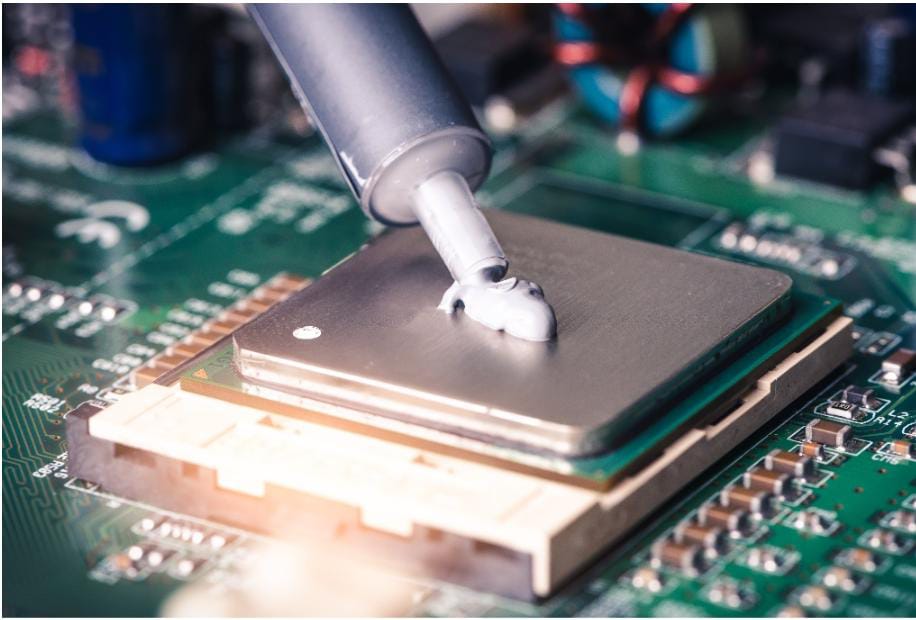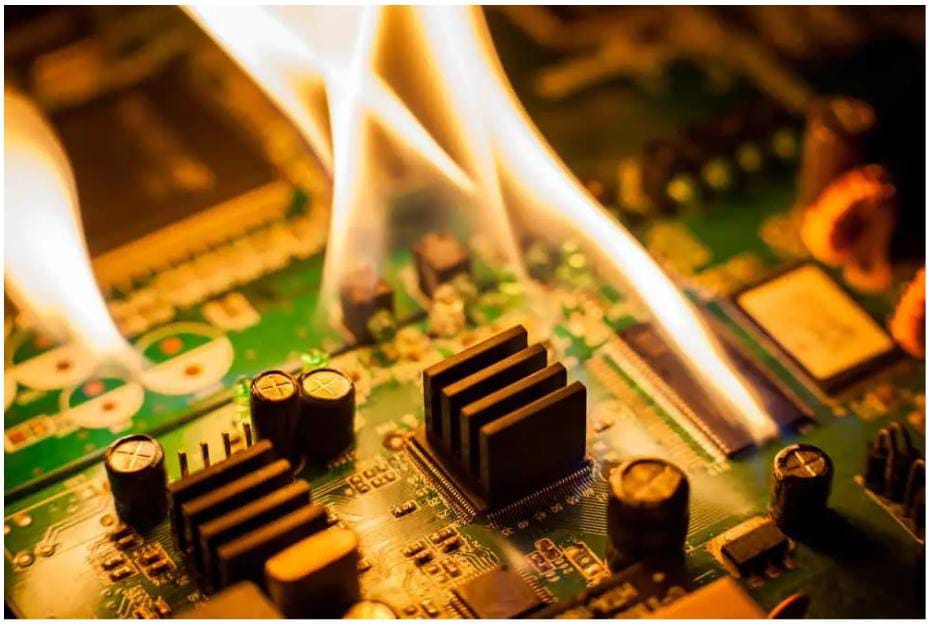Revolutionizing Thermal Management: The Latest Innovations In CPU Cooling
I. Introduction
In the dynamic landscape of computer hardware, where performance benchmarks are constantly pushed to new heights, thermal management stands as a cornerstone of efficient operation. Thermal paste is often used as a crucial component in thermal management. Thermal paste is a conductive material that is applied between the CPU and its cooler, allowing for better heat transfer and dissipation. You can learn more about the importance of thermal paste and its impact on CPU temperatures in this article from Technoburst.com.

A. The Importance Of Thermal Management In CPU Performance
The significance of thermal management in CPU performance cannot be overstated. CPUs are the workhorses of modern computing, executing billions of instructions per second to carry out tasks ranging from simple calculations to complex computations. However, this rapid processing generates significant amounts of heat, which, if not properly dissipated, can lead to a myriad of issues, including thermal throttling, reduced lifespan, and even outright failure.
Thermal management is essential for maintaining the CPU within its optimal operating temperature range. Operating beyond this range can lead to a phenomenon known as thermal throttling, wherein the CPU reduces its clock speed to prevent overheating, thereby compromising performance. Moreover, prolonged exposure to high temperatures can degrade the CPU’s internal components, shortening its lifespan and increasing the risk of hardware failure.
Effective thermal management not only ensures the stability and reliability of the CPU but also plays a crucial role in unlocking its full potential. By maintaining optimal operating temperatures, users can harness the full power of their CPUs, enabling smoother multitasking, faster computations, and improved overall system responsiveness.
II. Traditional CPU Cooling Methods
Over the years, various cooling methods have been developed to address the thermal challenges posed by high-performance CPUs. These methods can be broadly categorized into three main types: air cooling, liquid cooling, and the use of thermal pastes and pads. Each approach offers unique advantages and trade-offs, catering to the diverse needs and preferences of users.
A. Air Cooling
Air cooling is perhaps the most common and cost-effective method of cooling. It typically involves the use of heatsinks, which dissipate heat through convection, aided by one or more fans. Heatsinks are typically made of materials with high thermal conductivity, such as copper or aluminum, and are designed to maximize surface area for efficient heat dissipation.
Air cooling solutions come in various forms, ranging from stock coolers bundled with CPUs to high-performance aftermarket solutions. While air coolers are generally easy to install and maintain, their effectiveness can be limited by factors such as airflow restrictions, ambient temperature, and thermal conductivity of the CPU.
B. Liquid Cooling
Liquid cooling offers a more advanced alternative to air cooling, leveraging the superior thermal conductivity of liquids to dissipate heat more efficiently. Liquid cooling systems typically consist of a pump, radiator, water block, and tubing filled with coolant. The pump circulates the coolant through the water block, which is in direct contact with the CPU, absorbing heat. The heated coolant is then transported to the radiator, where it dissipates heat into the surrounding environment.
Liquid cooling solutions are favored by enthusiasts and overclockers for their ability to provide superior thermal performance and quieter operation compared to air cooling. However, they tend to be more complex and expensive to install, requiring careful consideration of factors such as system compatibility, maintenance requirements, and potential risks of leakage.
C. Thermal Pastes And Pads
In addition to air and liquid cooling solutions, thermal pastes and pads play a crucial role in optimizing thermal conductivity between the CPU and its cooler. These thermal interface materials fill microscopic imperfections in the surfaces of the CPU and heatsink, ensuring efficient heat transfer.
Thermal pastes are typically composed of a mixture of silicone-based compounds with high thermal conductivity, while thermal pads are made of materials such as graphite or ceramic. Proper application of thermal pastes and pads is essential for minimizing thermal resistance and maximizing heat transfer efficiency.

III. Emerging Trends In Cooling CPU
In the relentless pursuit of optimizing CPU performance and efficiency, the landscape of CPU cooling is witnessing a wave of innovation driven by cutting-edge technologies and advanced materials. These emerging trends not only promise to revolutionize thermal management but also pave the way for unprecedented levels of performance and reliability.
A. Advanced Materials: Harnessing The Power Of Graphene And Carbon Nanotubes
At the forefront of this revolution are advanced materials like graphene and carbon nanotubes, hailed for their exceptional thermal conductivity properties. Graphene, a single layer of carbon atoms arranged in a hexagonal lattice, exhibits extraordinary thermal conductivity, making it an ideal candidate for enhancing heat dissipation in cooling CPU solutions.
Similarly, carbon nanotubes, cylindrical structures composed of carbon atoms, boast remarkable thermal conductivity and mechanical strength. When integrated into cooling CPU systems, these nanomaterials offer unparalleled heat transfer capabilities, enabling more efficient thermal management and higher performance levels.
B. Vapor Chamber Cooling Technology: Redefining Thermal Dissipation
Vapor chamber cooling technology represents another groundbreaking advancement in cooling CPU solutions. Unlike traditional heat pipes, which rely on the phase change of a working fluid to transfer heat, vapor chambers utilize a two-phase cooling process involving liquid-to-vapor phase transition within a sealed chamber.
This innovative approach enables vapor chamber coolers to achieve higher thermal conductivity and heat dissipation rates, effectively spreading heat across a larger surface area. As a result, vapor chamber cooling technology holds the potential to deliver superior thermal performance and greater overclocking capabilities, catering to the demands of enthusiasts and high-performance computing applications.
C. Direct Die Cooling Solutions: Enhancing Thermal Efficiency
Direct die cooling solutions are emerging as a promising alternative to conventional cooling methods, offering more direct and efficient heat transfer pathways. Unlike traditional heatsinks, which rely on thermal interface materials to bridge the gap between the CPU and cooler, direct die cooling solutions establish direct contact between the CPU die and the cooling element.
By eliminating the thermal resistance introduced by interface materials, direct die cooling solutions can achieve higher levels of thermal conductivity and heat dissipation efficiency. This results in lower operating temperatures, reduced thermal throttling, and enhanced overall system performance, particularly in high-demand computing scenarios.
D. Innovations In Heat Dissipation: Micro-Fin Arrays And Nanofluids
In addition to advancements in cooling technologies, innovations in heat dissipation mechanisms are also reshaping the landscape of cooling CPU. Micro-fin arrays and heat sinks, featuring densely packed fins with intricate geometries, are designed to maximize surface area for efficient heat transfer.
By increasing the surface area available for convective heat exchange, micro-fin arrays and heat sinks enhance the effectiveness of cooling CPU, enabling more efficient thermal management and improved performance levels.
Furthermore, the utilization of nanofluids, engineered suspensions containing nanoparticles dispersed in a base fluid, holds tremendous potential for enhancing heat transfer capabilities. Nanofluids exhibit unique thermal properties, such as increased thermal conductivity and convective heat transfer coefficients, which can significantly improve the efficiency of cooling systems.

Frequently Asked Questions (FAQ)
Q1.What are the latest innovations in cooling CPU technology?
Answer: The latest innovations include advancements in materials like graphene and carbon nanotubes, vapor chamber cooling, direct die cooling solutions, phase-change cooling systems, and integration of AI for intelligent cooling.
Q2.How do these innovations improve thermal management in CPUs?
Answer: These innovations offer better heat dissipation, more efficient cooling, and improved thermal conductivity, resulting in enhanced performance and longevity of CPUs.
Q3.Are these new cooling technologies compatible with existing CPU designs?
Answer: Yes, many of these innovations are designed to be compatible with existing CPU architectures, offering improved cooling solutions without requiring significant changes to hardware designs.
Q4.Do these advancements impact energy consumption and efficiency?
Answer: Yes, many of the latest cooling technologies prioritize energy efficiency, leading to reduced power consumption and lower operating costs for users.
Q5.How do these innovations address the challenges of thermal throttling in high-performance CPUs?
Answer: These innovations provide more effective heat dissipation, allowing CPUs to maintain optimal operating temperatures even under heavy workloads, thereby reducing the occurrence of thermal throttling and improving overall performance.
Conclusion
Innovative cooling solutions play a pivotal role in unlocking the full potential of modern computing while addressing the challenges of thermal management and environmental sustainability. This resource covers everything from the basics of assembly programming to advanced techniques for optimizing code of the computer architecture and understanding the inner workings of CPUs. As the landscape of CPU cooling continues to evolve and innovate, it is essential for software engineers to stay updated and knowledgeable in order to fully harness the potential of modern computing.
Stay in touch to get more news & updates on Discover Tribune!






